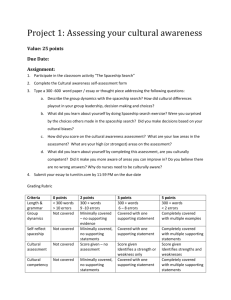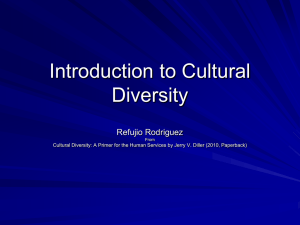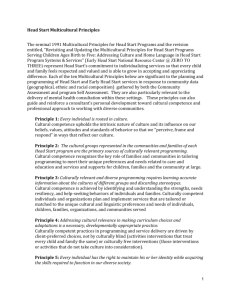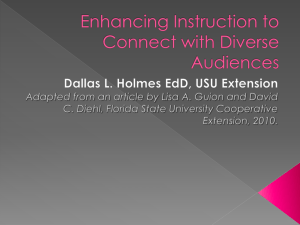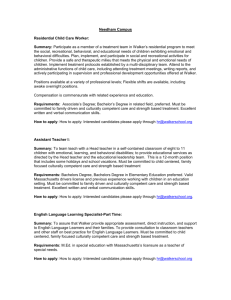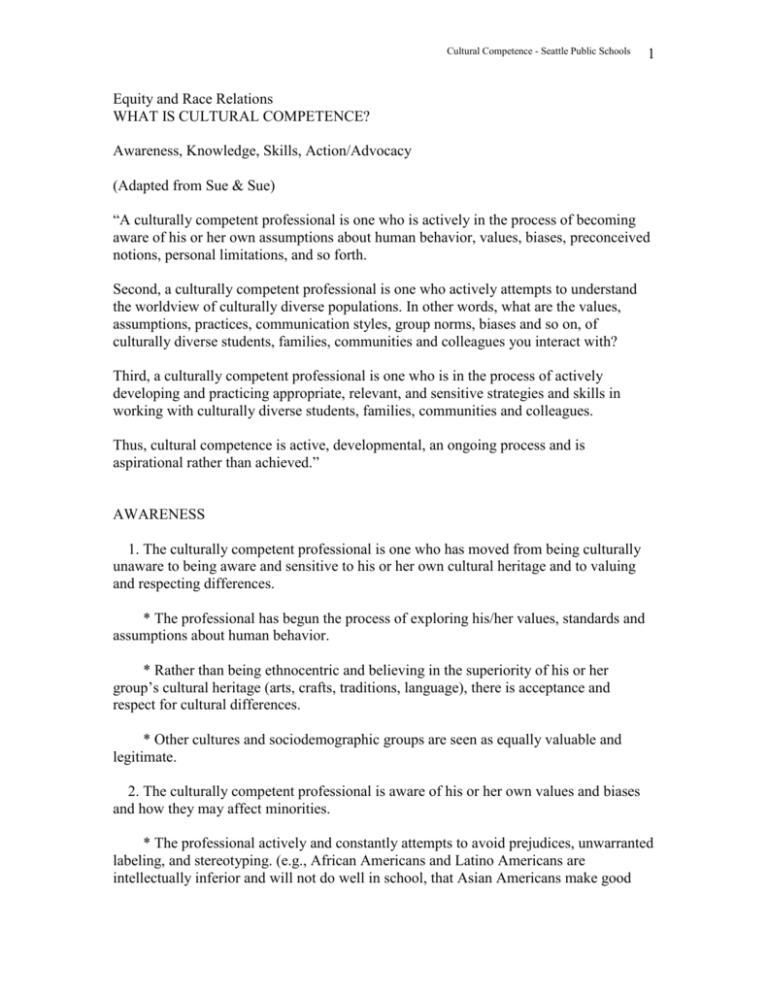
Cultural Competence - Seattle Public Schools
1
Equity and Race Relations
WHAT IS CULTURAL COMPETENCE?
Awareness, Knowledge, Skills, Action/Advocacy
(Adapted from Sue & Sue)
“A culturally competent professional is one who is actively in the process of becoming
aware of his or her own assumptions about human behavior, values, biases, preconceived
notions, personal limitations, and so forth.
Second, a culturally competent professional is one who actively attempts to understand
the worldview of culturally diverse populations. In other words, what are the values,
assumptions, practices, communication styles, group norms, biases and so on, of
culturally diverse students, families, communities and colleagues you interact with?
Third, a culturally competent professional is one who is in the process of actively
developing and practicing appropriate, relevant, and sensitive strategies and skills in
working with culturally diverse students, families, communities and colleagues.
Thus, cultural competence is active, developmental, an ongoing process and is
aspirational rather than achieved.”
AWARENESS
1. The culturally competent professional is one who has moved from being culturally
unaware to being aware and sensitive to his or her own cultural heritage and to valuing
and respecting differences.
* The professional has begun the process of exploring his/her values, standards and
assumptions about human behavior.
* Rather than being ethnocentric and believing in the superiority of his or her
group’s cultural heritage (arts, crafts, traditions, language), there is acceptance and
respect for cultural differences.
* Other cultures and sociodemographic groups are seen as equally valuable and
legitimate.
2. The culturally competent professional is aware of his or her own values and biases
and how they may affect minorities.
* The professional actively and constantly attempts to avoid prejudices, unwarranted
labeling, and stereotyping. (e.g., African Americans and Latino Americans are
intellectually inferior and will not do well in school, that Asian Americans make good
Cultural Competence - Seattle Public Schools
2
technical workers but poor managers, that women belong in the home or that the elderly
are no longer useful in society).
* Culturally competent professionals try not to hold preconceived limitations and
notions about culturally diverse people.
* The professional actively challenges their assumptions; tries to find effective ways
to work cross-culturally; and monitors their functioning via consultations, supervision,
and professional development.
3. Culturally competent professionals are comfortable with differences that exist
between themselves and others in terms of race, gender, sexual orientation, and other
socio-demographic variables. Differences are not seen as negative.
* The culturally competent professional does not profess color blindness or negate
the existence of differences in behavior, attitudes, cultural norms, beliefs, etc., among
different groups.
4. The culturally competent professional is sensitive to circumstances (personal biases;
stage of racial, gender, and sexual orientation identity; sociopolitical influences, etc) that
may dictate referral of a student to a member of his or her own socio-demographic group
or to another professional in general.
* A culturally competent professional is aware of his or her limitations and is not
threatened by the prospect of seeking assistance and support from others.
However...
* This principle should not be used as a cop-out for the professional who does not
want to work with culturally diverse students, staff and families, or who do not want to
work through their own personal hang-ups.
5. The culturally competent professional acknowledges and is aware of his or her own
racist, sexist, heterosexist, or other detrimental attitudes, beliefs, behaviors, and feelings.
* A culturally competent professional does not deny the fact that he or she has
directly or indirectly benefited from individual, institutional, and cultural biases and that
he or she has been socialized into such a society. As a result, the culturally competent
professional inherits elements in the socialization process that may be detrimental to
culturally and ethnically diverse students, staff and families.
* Culturally competent professionals accept responsibility for their own racism,
sexism, heterosexism, etc., and attempts to deal with them in a non-defensive, guilt-free
manner. They have begun the process of defining a new non-oppressive and nonexploitive attitude. In terms of racism, for example, addressing one’s Whiteness (e.g.,
white privilege) is crucial for effective teaching.
Cultural Competence - Seattle Public Schools
3
Back to top
KNOWLEDGE
1. The culturally competent professional must possess specific knowledge and
information about the particular group he or she is working with.
* The professional must be aware of the history, experiences, cultural values, and
lifestyles of various socio-demographic groups in our society.
* The professional understands the idea that the greater the depth of knowledge of
one cultural group and the more knowledge the professional has of many groups, the
more likely it is that he/she can be effective in his/her role.
* Thus, the culturally competent professional is one who continues to explore and
learn about issues related to various minority groups throughout his or her professional
career.
2. The culturally competent professional will have a good understanding of the
sociopolitical system’s operating in the United States with respect to treatment of
marginalized groups in our society.
* The culturally competent professional understands the impact and operation of
oppression (racism, sexism, heterosexism, etc.), the politics of the education system, and
the racist, sexist, and homophobic concepts that have permeated institutions.
* Especially valuable for the educator is an understanding of the role that
ethnocentric monoculturalism plays in the development of identity and worldviews
among minority groups.
3. The culturally competent professional must have clear and explicit knowledge and
understanding of the generic characteristics in individuals from diverse ethnic, racial and
socioeconomic backgrounds.
* These encompass language factors, culture-bound values, and class-bound values.
The professional should understand the value assumptions (normality and abnormality)
inherit in education and how they may interact with values of the culturally different
student, staff, and families.
* In some cases, applying theories or models to a particular group, may limit the
potential of persons from different cultures. Likewise, being able to determine those that
may be useful to culturally and ethnically diverse individuals is important.
Cultural Competence - Seattle Public Schools
4
4. The culturally competent professional is aware of institutional barriers that prevent
some diverse students and families from accessing services.
* Important factors include the location of services, the formality or informality of
décor, advertising services and events in English only, where event are publicized, the
availability of minorities, school climate, hours and days of operation, transportation,
childcare, and how services/events are viewed by some cultures.
Back to top
SKILLS
1. At the skills level, the culturally competent professional must be able to generate a
wide variety of verbal and nonverbal responses.
* Mounting evidence indicates that different groups may not only define problems
differently from their majority counterparts, but also respond differently to teaching
styles.
* Thus, the wider the repertoire of responses and pedagogy the educator possesses,
the better educator he or she is likely to be.
* We can no longer rely on a very narrow and limited number of skills in teaching.
We need to practice and be comfortable with a multitude of teaching styles and
modalities.
2. The culturally competent professional must be able to send and receive both verbal
and nonverbal messages accurately and appropriately.
* The culturally skilled professional must be able not only to communicate (send)
his or her thoughts and feelings to the student/family, but also to read (receive) messages
from the student/family (verbal and nonverbal messages).
* Sending and receiving a message accurately means the ability to consider cultural
cues operating within a setting.
* Accuracy of communication must be tempered by its appropriateness. In many
cultures, subtlety and indirectness are appreciated. Likewise, others appreciate directness
and confrontation.
3. The culturally competent professional is able to exercise a variety relationship
building skills with his or her students, family members and co-workers when
appropriate.
Cultural Competence - Seattle Public Schools
5
* This implies that teaching may involve out-of-classroom strategies including;
attending special events, outreach, acting as a change agent, and home/community visits.
4. The culturally competent professional is aware of his or her helping style,
recognizes the limitations that he or she possesses, and can anticipate the impact on
culturally diverse students.
* When teaching-style adjustments appear too difficult, the next best thing to do
may be to
a) acknowledge your limitations and consult with other professionals;
b) anticipate the impact your limitations have on others;
c) participate in Culturally Relevant Professional Development.
* These things may communicate several things to your culturally diverse students,
families and coworkers: first that you are open and honest about your style of
communication and the limitations or barriers they may potentially cause; second, that
you understand enough about their worldview to anticipate how this may adversely affect
them; third, that as a professional, it is important for you to communicate your desire to
help despite your limitations; and fourth, that you care enough to do something about it.
Adapted from Sue, D.W., & Sue, D (2003). Counseling the culturally diverse: Theory
and practice, 4th Ed. New York: John Wiley.
Back to top
SKILLS SPECIFIC TO EDUCATORS
1. The culturally competent educator exercises culturally responsive instructional
strategies with his/her students on a daily basis.
* Has high expectations for each student; believes every child is highly capable
despite their background, history, or negative life experiences. However, the teacher uses
this information to inform them of how to work more effectively with their student.
* Motivates each student to push themselves.
* Works hard to reach hard to reach students.
* Builds a relationship with the parent/family including contacting them with
regards to successes, finding out how their child learns best, and communicating with
them on progress.
Cultural Competence - Seattle Public Schools
6
* Respect is not assumed. Works to earn respect through demonstrating equitable
treatment and holding students accountable to culturally relevant classroom expectations.
* Understands that the students’ success is dependent on addressing the needs of the
whole child (e.g., the role of parent/family, learning supports, previous teachers, etc)
2. The culturally competent professional is skilled at differentiated instructional
strategies, acknowledging the diverse learning styles of his/her students.
* Begins with the student where the student is at (e.g., Ebonics), prior knowledge,
his/her experiences.
* Engages students across varied learning styles and multiple intelligences:
kinesthetic, logical, interpersonal, intrapersonal, musical/rhythmic, verbal and
visual/spatial.
* Finds different ways for students to understand the information. Utilizes various
instructional strategies recognizing that one size does not fit all.
* Provides rigorous and challenging instruction. Asks questions that encourage
critical thinking skills.
3. The culturally competent professional assesses the curriculum used in the classroom
for its multicultural and anti-bias qualities.
* Uses supplemental materials when needed to meet the needs of diverse learning
styles of students and to assist with development of a curriculum that is more inclusive of
diversity.
* Makes every effort possible to select materials which accurately represent
ethnically and culturally diverse groups including women and people with disabilities
which challenge common misconceptions and stereotypes.
* Uses culturally relevant curriculum that reflects the diversity of the students in the
classroom and does so in positive ways.
* Teaches African American history throughout the year, not just during Black
history month as well as the history of other groups who have contributed to US history.
This includes issues that occur across the nation that prepare students to live in a global
society.
* When curriculum has bias qualities from a historical perspective, provides
meaningful context that provides accurate up to date information about that particular
group and helps students identify the historical context in which the materials were
written e.g., seeing Native Americans as savages or African Americans as slaves.
Cultural Competence - Seattle Public Schools
7
4. Creates a classroom environment where students are able to think critically about
issues of diversity including race and equity and discuss these issues developmentally and
age appropriately.
* Middle and high school students have opportunity to explore cause and effect,
listen to others, identify power paradigm, bias, discrimination, oppression, and
marginalization.
* Addresses issues around bullying that evolve around race, class, and differences.
* Teacher is willing to learn from the students and understands that learning about
diverse cultures is an on-going process and that he or she is not the expert.
ADVOCACY/ACTION
(Adapted from Judith H. Katz)
Cultural Racism:
“These aspects of society that overtly and covertly attribute value and normality to white
people and whiteness, and devalue, stereotype, and label people of color as “other”,
different, less than, or render them invisible.”
--Teaching for Diversity and Social Justice, Adams, Bell & Griffin
Ways to combat racism:
* Educate co-workers and close friends about racism.
* Know your roots and share your pride in your heritage with others.
* Be mindful of your language. Avoid stereotypical remarks and challenge those made
by others.
* Speak out against jokes and slurs that target people or groups. Silence sends a
message that you are in agreement. It is not enough to refuse to laugh.
* Openly disagree with racist comments or actions of those around you.
* Be knowledgeable; provide as much accurate information as possible to reject
harmful myths and stereotypes. Discuss as a family the impact of prejudicial attitudes and
behavior.
* Research your family tree and trace your family's involvement in the struggle for
civil and human rights or the immigration experience. Identify personal heroes and
positive role models.
* Read and encourage your children to read books that promote understanding of
different cultures as well as those that are written by authors of diverse backgrounds.
Cultural Competence - Seattle Public Schools
8
* Become aware of your city's demographics and compare it to others around the
country to better understand the diversity in your community.
* Encourage the free flow of ideas in all spaces.
* Plan family outings to diverse neighborhoods in and around your community and
visit local museums, galleries and exhibits that celebrate art forms of different cultures.
* Visit important landmarks in your area associated with the struggle for human and
civil rights such as museums, public libraries and historical sites.
* Act as a role model, take risks and question the White power structure.
* Establish discussions and other activities in your school, workplace, and home that
explore race, ethnicity, and culture e.g., book studies, films, journal articles, exercises,
etc.
* Look at your own racist attitudes and behaviors and their impact on individuals and
groups.
* Take the time to complain to those in charge when you notice racism inside and
outside of your school or work place.
* Demonstrate a willingness to change self versus others as it relates to cultural norms,
values, attitudes, and behaviors.
* Actively support initiatives, organizations, and people working for anti-racism.
* Examine your own cultural norms to better understand how they influence crosscultural interactions.
* Raise issues in your workplace with people in power, co-workers and staff.
* Change what normally appears on bulletin boards, walls, handouts, newsletters, and
other materials relevant to race, ethnicity, and culture.
* Be a referral resource: direct individuals to people or groups who might be of
assistance.
* Allocate and use resources in a way that promotes equity for students of color.
* Assess the cultural environment of your workplace to ensure that it reflects and
honors the diversity of students and staff (e.g., assemblies, activities/events, décor,
number of staff of color).
Cultural Competence - Seattle Public Schools
9
* Intentionally seek and participate in CRPD aimed to enhance your own awareness,
knowledge and skills in effectively working cross-culturally.
* Make sure that your organizations evaluations and assessment tools take into
consideration issues of racism, power, privilege, and oppression.
* Investigate curricula in your classroom for cultural relevance and anti-bias qualities.
* Align curriculum within your grade level and the school vs. independent teaching.
* Include diverse ethnic and socio-economic representation in decision making.
* Engage in conversations around race and social justice issues with your students and
colleagues.
--Katz, J.H. (1978) White Awarness: Handbook for anti-racism training. Oklahoma Press.
* Check out this handy booklet I Can Fix It published by artist, author and speaker
damali ayo.
©2009 Seattle Public Schools All rights reserved



